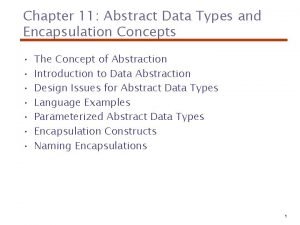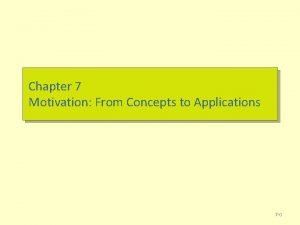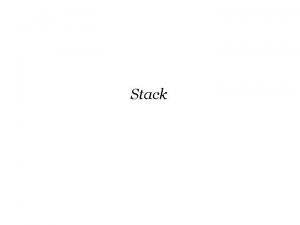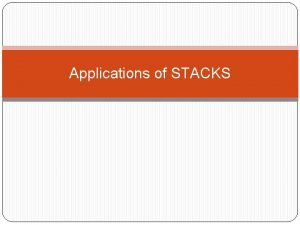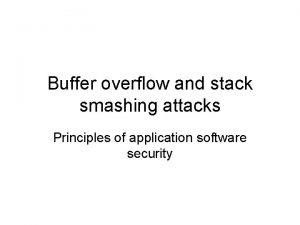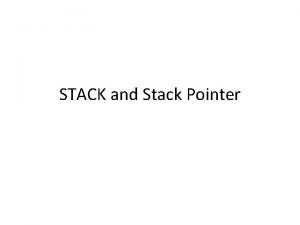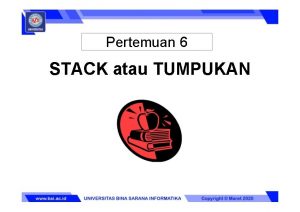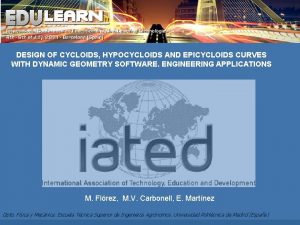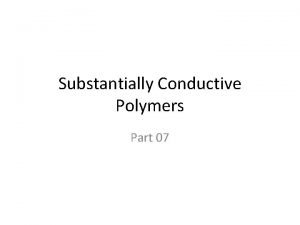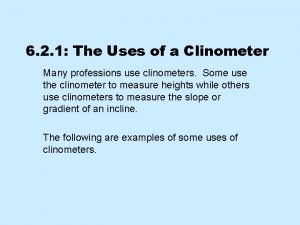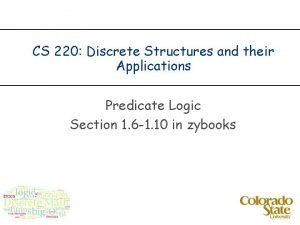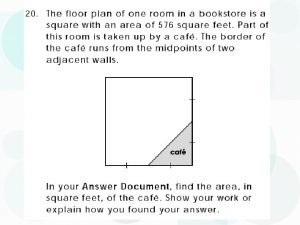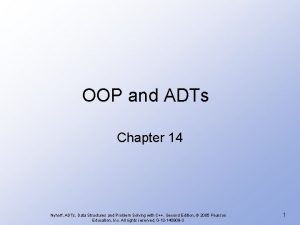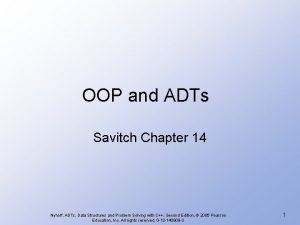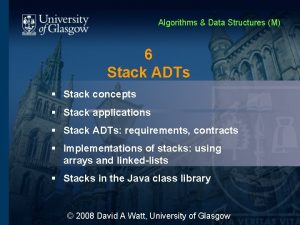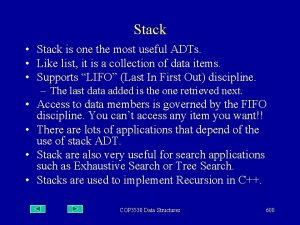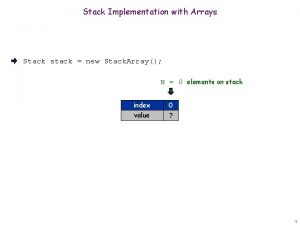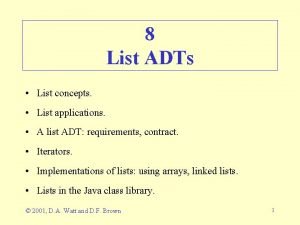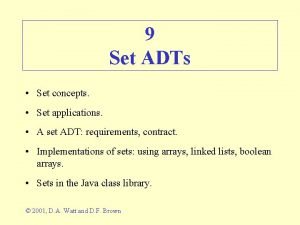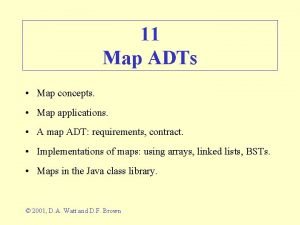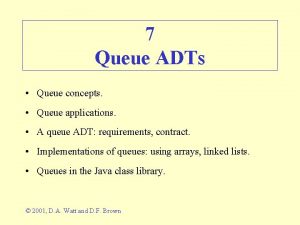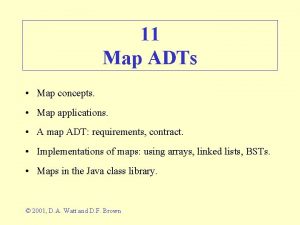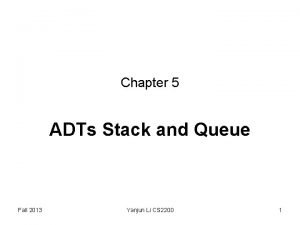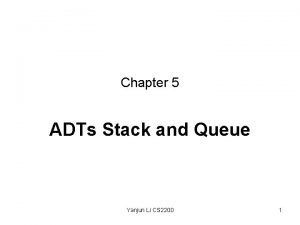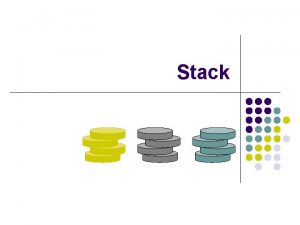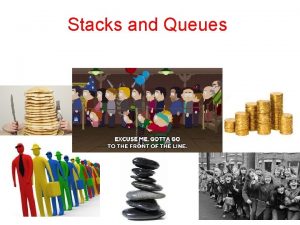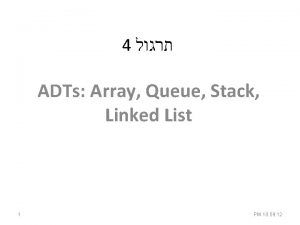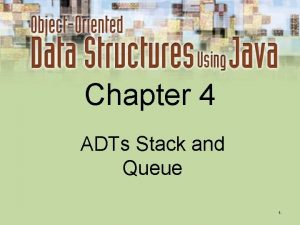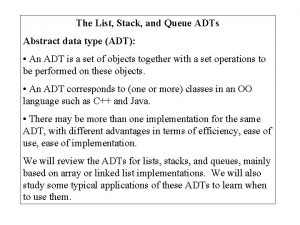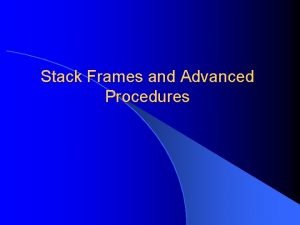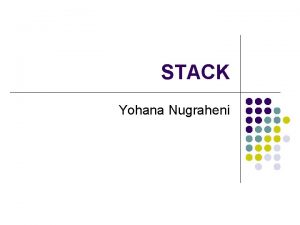6 Stack ADTs Stack concepts Stack applications A























- Slides: 23

6 Stack ADTs • Stack concepts. • Stack applications. • A stack ADT: requirements, contract. • Implementations of stacks: using arrays, linked lists. • Stacks in the Java class library. © 2001, D. A. Watt and D. F. Brown

Stack concepts (1) • A stack is a last-in-first-out sequence of elements. Elements can added and removed only at one end (the top of the stack). • The depth of stack is the number of elements it contains. • An empty stack has depth zero.

Stack concepts (2) • Illustration (stack of books): Initially: Rob Roy War & Peace Moby Dick After removing a book: War & Peace Moby Dick After adding “Misérables”: After adding “ 2001”: Misérables War & Peace Moby Dick 2001 Misérables War & Peace Moby Dick

Stack applications • Interpreter (e. g. , the Java Virtual Machine) § maintains a stack containing intermediate results during evaluation of complicated expressions § also containing arguments and return addresses for method calls and returns. • Parser (e. g. , a component of the Java compiler) § maintains a stack containing symbols encountered during parsing.

Example 1: text-file reversal • A text file is a sequence of (zero or more) lines. • To reverse the order of these lines, we must store them in a first-in-last-out sequence. • Text-file reversal algorithm: To output the lines of file in reverse order: 1. 2. 3. 4. Make line-stack empty. For each line read from file, repeat: 2. 1. Add line to the top of line-stack. While line-stack is not empty, repeat: 3. 1. Remove a line from the top of line-stack into line. 3. 2. Output line. Terminate.

Example 2: bracketing (1) • A phrase is well-bracketed if: § for every left bracket, there is a later matching right bracket § for every right bracket, there is an earlier matching left bracket § the subphrase between a pair of matching brackets is itself wellbracketed. • Examples (mathematical expressions): s (s – a) (s – b) (s – c) (– b + [b 2 – 4 ac]) / 2 a s (s – a) (s – b (s – c) s (s – a) s – b) (s – c) (– b + [b 2 – 4 ac)] / 2 a well-bracketed ill-bracketed

Example 2 (2) • Bracket matching algorithm: To test whether phrase is well-bracketed: 1. 2. Make bracket-stack empty. For each symbol sym in phrase (scanning from left to right), repeat: 2. 1. If sym is a left bracket: 2. 1. 1. Add sym to the top of bracket-stack. 2. 2. If sym is a right bracket: 2. 2. 1. If bracket-stack is empty, terminate with false. 2. 2. 2. Remove a bracket from the top of bracket-stack into 2. 2. 3. left. If left and sym are not matched brackets, terminate 3. with false. Terminate with true if bracket-stack is empty, or false otherwise.

Stack ADT: requirements • Requirements: 1) It must be possible to make a stack empty. 2) It must be possible to add (‘push’) an element to the top of a stack. 3) It must be possible to remove (‘pop’) the topmost element from a stack. 4) It must be possible to test whether a stack is empty. 5) It should be possible to access the topmost element in a stack without removing it.

Stack ADT: contract (1) • Possible contract, expressed as a Java interface: public interface Stack { // Each Stack object is a stack whose elements are objects. //////// Accessors //////// public boolean is. Empty (); // Return true if and only if this stack is empty. public Object get. Last (); // Return the element at the top of this stack.

Stack ADT: contract (2) • Possible contract (continued): //////// Transformers //////// public void clear (); // Make this stack empty. public void add. Last (Object elem); // Add elem as the top element of this stack. public Object remove. Last (); // Remove and return the element at the top of this stack. }

Implementation of stacks using arrays (1) • Represent a bounded stack (depth maxdepth) by: § variable depth, containing the current depth § array elems of length maxdepth, containing the stacked elements in elems[0… depth– 1]. topmost element Invariant: 0 1 element length=0 unoccupied depth– 1 depth element maxdepth– 1 1 maxdepth– 1 Empty stack: Illustration (maxdepth = 6): 1 0 2 Moby War & Rob Dick Peace Roy depth=3 4 5

Implementation using arrays (2) • Java implementation: public class Array. Stack implements Stack { private Object[] elems; private int depth; //////// Constructor //////// public Array. Stack (int max. Depth) { elems = new Object[max. Depth]; depth = 0; }

Implementation using arrays (3) • Java implementation (continued): //////// Accessors //////// public boolean is. Empty () { return (depth == 0); } public Object get. Last () { if (depth == 0) throw …; return elems[depth-1]; }

Implementation using arrays (4) • Java implementation (continued): //////// Transformers //////// public void clear () { for (int i = 0; i < depth; i++) elems[i] = null; depth = 0; } public void add. Last (Object elem) { if (depth == elems. length) throw …; elems[depth++] = elem; }

Implementation using arrays (5) • Java implementation (continued): public Object remove. Last () { if (depth == 0) throw …; Object top. Elem = elems[--depth]; elems[depth] = null; return top. Elem; } } • Analysis: § Operations is. Empty, get. Last, add. Last, remove. Last have time complexity O(1). § Operation clear has time complexity O(n).

Implementation of stacks using SLLs (1) • Represent an (unbounded) stack by an SLL, such that the first node contains the topmost element Invariant: element Empty stack: Illustration: Rob Roy War & Peace Moby Dick

Implementation using SLLs (2) • Java implementation: public class Linked. Stack implements Stack { private SLLNode top; //////// Constructor //////// public Linked. Stack () { top = null; }

Implementation using SLLs (3) • Java implementation (continued): //////// Accessors //////// public boolean is. Empty () { return (top == null); } public Object get. Last () { if (top == null) throw …; return top. element; }

Implementation using SLLs (4) • Java implementation (continued): //////// Transformers //////// public void clear () { top = null; } public void add. Last (Object elem) { top = new SLLNode(elem, top); }

Implementation using SLLs (5) • Java implementation (continued): public Object remove. Last () { if (top == null) throw …; Object top. Elem = top. element; top = top. succ; return top. Elem; } } • Analysis: § All operations have time complexity O(1).

Stacks in the Java class library • Java provides no Stack interface or class as such. • However, the java. util. Linked. List class provides all the above Stack operations. • Illustration: import java. util. Linked. List; Linked. List book. Stack = new Linked. List(); book. Stack. add. Last("Moby Dick"); book. Stack. add. Last("War & Peace"); book. Stack. add. Last("Rob Roy"); System. out. println(book. Stack. remove. Last());

Example 3: text-file reversal revisited (1) • Recall the text-file reversal algorithm of Example 1. • Implementation: public static void reverse ( Buffered. Reader input, Buffered. Writer output) throws IOException { Linked. List line. Stack = new Linked. List(); for (; ; ) { String line = input. read. Line(); if (line == null) break; // end of input line. Stack. add. Last(line);

Example 3 (2) • Implementation (continued): while (! line. Stack. is. Empty()) { String line = line. Stack. remove. Last(); output. write(line + "n"); } output. close(); }
 Parameterized adts is also known as
Parameterized adts is also known as Adts ukiah
Adts ukiah Adts, data structures, and problem solving with c++
Adts, data structures, and problem solving with c++ Parameterized abstract data types
Parameterized abstract data types Motivation from concepts to applications
Motivation from concepts to applications Starr evers starr biology concepts and applications
Starr evers starr biology concepts and applications Human genetics concepts and applications 10th edition
Human genetics concepts and applications 10th edition Stack adt
Stack adt Applications of stack
Applications of stack Smash the stack
Smash the stack What is stack pointer
What is stack pointer Diketahui suatu stack dgn max_stack = 6
Diketahui suatu stack dgn max_stack = 6 Application of epicycloid in engineering
Application of epicycloid in engineering Consumer oriented e commerce applications
Consumer oriented e commerce applications Applications of ppv
Applications of ppv Advantages of threaded binary tree
Advantages of threaded binary tree Clinometer definition and uses
Clinometer definition and uses Applications of plastics
Applications of plastics Applications of predicates and quantifiers
Applications of predicates and quantifiers Hydraulic jump applications
Hydraulic jump applications Skills and applications chapter 3
Skills and applications chapter 3 Technology applications program office
Technology applications program office Ac voltage controller applications
Ac voltage controller applications 8-7 applications of right triangle trigonometry
8-7 applications of right triangle trigonometry



